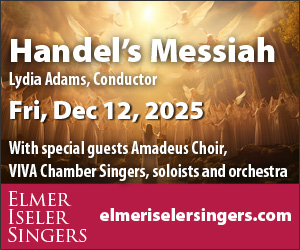Reflecting one person’s imagination, musical composition is an intimate art. But, especially if the creation is wide-ranging and sonically multihued, sympathetic interpreters are needed to express the composer’s vision. As this group of CDs demonstrates, notable interpretations of a composer’s singular vision can illuminate the creators’ concepts.
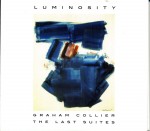 Of particular importance is the double disc set Luminosity – The Last Suites (Jazzcontinuum GCM 2014 jazzcontinuum.com). Double bassist, bandleader, author and educator, Graham Collier (1937-2011) was one of the United Kingdom’s most accomplished jazz composers starting in the late 1960s. Serendipitously both of his final suites were initially composed for and premiered by Canadian orchestras: The Blue Suite for a University of Victoria big band directed by Hugh Fraser and Luminosity for Paul Cram’s Upstream Orchestra in Halifax. However, one indication of Collier’s musical stature is that since he didn’t record these pieces, 15 of the UK’s top jazzers who had played with him over years convened to create this posthumous tribute. Each suite had a different conception. Luminosity is Collier’s translation into related sound pictures of some of Hans Hofmann’s abstract paintings. In contrast The Blue Suite uses motifs expressed on Miles Davis’ Kind of Blue LP without ever quoting those familiar themes. Making full use of Andy Panayi’s ethereal flute tone with the often romantic interplay of pianist Roger Dean, The Blue’s tunes are orchestrated with an exposition, narrative and summation. But preciousness is avoided. Swing strength is especially apparent on All Kinds, as John Marshall lets loose with a showy drum solo. Despite being mated with cascading trumpet triplets the effect doesn’t disrupt the suite’s flow. Still, the individuality of Collier’s skills is pinpointed with Kind Of Freddie. A feature for guitarist Ed Speight’s chordal style, moderato tutti passages pierced by string strums and brass yelps expose another sequence that is subtly revealed to be the suite’s recurring, connective motif. Building excitement via brass shouts and plunger work plus intense sax solos permeate tracks like Kind of So What as the blended undercurrent remains. On the other hand, Luminosity reflects the tension implicit in Hofmann’s influential colour relationships by shading the tunes with various musical inferences. Marshall’s jazz-rock styled drumming appears in one instance, as does a baroque-like pairing of flute and guitar. Above Deep Water for instance showcases a duel between a Harlem Nocturne-like line from Panayi’s alto sax and the restrained gravitas of James Allsopp’s bass clarinet. Finally, before the descriptive finale, a series of polyphonic smears are displayed on Blue Monolith named for a late Hofmann abstraction. Pumping horn vamps, snapping percussion and descending trumpet lines from Martin Shaw and Steve Waterman create an opaque, accelerating theme that reflects the orchestrator’s talents as well as the painter’s.
Of particular importance is the double disc set Luminosity – The Last Suites (Jazzcontinuum GCM 2014 jazzcontinuum.com). Double bassist, bandleader, author and educator, Graham Collier (1937-2011) was one of the United Kingdom’s most accomplished jazz composers starting in the late 1960s. Serendipitously both of his final suites were initially composed for and premiered by Canadian orchestras: The Blue Suite for a University of Victoria big band directed by Hugh Fraser and Luminosity for Paul Cram’s Upstream Orchestra in Halifax. However, one indication of Collier’s musical stature is that since he didn’t record these pieces, 15 of the UK’s top jazzers who had played with him over years convened to create this posthumous tribute. Each suite had a different conception. Luminosity is Collier’s translation into related sound pictures of some of Hans Hofmann’s abstract paintings. In contrast The Blue Suite uses motifs expressed on Miles Davis’ Kind of Blue LP without ever quoting those familiar themes. Making full use of Andy Panayi’s ethereal flute tone with the often romantic interplay of pianist Roger Dean, The Blue’s tunes are orchestrated with an exposition, narrative and summation. But preciousness is avoided. Swing strength is especially apparent on All Kinds, as John Marshall lets loose with a showy drum solo. Despite being mated with cascading trumpet triplets the effect doesn’t disrupt the suite’s flow. Still, the individuality of Collier’s skills is pinpointed with Kind Of Freddie. A feature for guitarist Ed Speight’s chordal style, moderato tutti passages pierced by string strums and brass yelps expose another sequence that is subtly revealed to be the suite’s recurring, connective motif. Building excitement via brass shouts and plunger work plus intense sax solos permeate tracks like Kind of So What as the blended undercurrent remains. On the other hand, Luminosity reflects the tension implicit in Hofmann’s influential colour relationships by shading the tunes with various musical inferences. Marshall’s jazz-rock styled drumming appears in one instance, as does a baroque-like pairing of flute and guitar. Above Deep Water for instance showcases a duel between a Harlem Nocturne-like line from Panayi’s alto sax and the restrained gravitas of James Allsopp’s bass clarinet. Finally, before the descriptive finale, a series of polyphonic smears are displayed on Blue Monolith named for a late Hofmann abstraction. Pumping horn vamps, snapping percussion and descending trumpet lines from Martin Shaw and Steve Waterman create an opaque, accelerating theme that reflects the orchestrator’s talents as well as the painter’s.
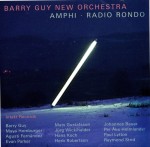 Another musician whose compositions are influenced by visual art as well as architecture and other sounds is British bassist Barry Guy. Amphi + Radio Rondo (Intakt CD 235 intaktrec.ch), demonstrates how he uses his 12-piece New Orchestra (BGNO) to frame solo concertos. Suggested by Elana Gutmann paintings, Amphi places Maya Homburger’s structured soloing on baroque violin within the context of polyphonic eruptions from the BGNO. While the initial sequences suggest that violin interludes are trading off with band parts, by the final movements the string part is firmly embedded. Even before that, Homburger’s expressive spiccato sweeps and staccato scratches are prominent enough that clusters of reed buzzing, brass lowing or clumping percussion appropriately comment on her solos. Helped by a pulsed continuum from pianist Agustí Fernández, tubaist Per Åke Holmlander and Guy’s double bass, her tremolo string vibrations harmonize alongside the horn and reed section before the climax, where every instrument’s timbres deconstruct into multiphonic shards. Moving upwards from near silence to a crescendo of yelps, cries and trills, the fiddler’s centrality is re-established with a coda of strident scrubs. Fernández is the soloist on the slightly lengthier Radio Rondo. Here though his passing chords and cascading runs face head-on challenges from others’ extended technique, including Evan Parker’s circular breathed soprano saxophone smears and speedy slurs from trombonist Johannes Bauer. The keyboardist’s high-energy key fanning and kinetic cascades inject more energy into the proceedings plus emotional dynamics. Confident, Fernández mixes the physicality of a concert pianist with the close listening of a big band soloist like Earl Hines, as a series of ever-more dramatic crescendos solidify the ensemble into as much pure swing as an experimental ensemble can muster, complete with blasting high notes from trumpeter Herb Robertson. With the structure of the piece finally apparent, the final rondo could be the soundtrack for an experimental war film, with agitated piano comping, plunger slurps from the brass and reed multiphonics as well as pounding percussion. Just when it seems the peak can’t be heightened, the piece abruptly ends as if a radio has been switched off. It`s an exhausting yet exhilarating triumph.
Another musician whose compositions are influenced by visual art as well as architecture and other sounds is British bassist Barry Guy. Amphi + Radio Rondo (Intakt CD 235 intaktrec.ch), demonstrates how he uses his 12-piece New Orchestra (BGNO) to frame solo concertos. Suggested by Elana Gutmann paintings, Amphi places Maya Homburger’s structured soloing on baroque violin within the context of polyphonic eruptions from the BGNO. While the initial sequences suggest that violin interludes are trading off with band parts, by the final movements the string part is firmly embedded. Even before that, Homburger’s expressive spiccato sweeps and staccato scratches are prominent enough that clusters of reed buzzing, brass lowing or clumping percussion appropriately comment on her solos. Helped by a pulsed continuum from pianist Agustí Fernández, tubaist Per Åke Holmlander and Guy’s double bass, her tremolo string vibrations harmonize alongside the horn and reed section before the climax, where every instrument’s timbres deconstruct into multiphonic shards. Moving upwards from near silence to a crescendo of yelps, cries and trills, the fiddler’s centrality is re-established with a coda of strident scrubs. Fernández is the soloist on the slightly lengthier Radio Rondo. Here though his passing chords and cascading runs face head-on challenges from others’ extended technique, including Evan Parker’s circular breathed soprano saxophone smears and speedy slurs from trombonist Johannes Bauer. The keyboardist’s high-energy key fanning and kinetic cascades inject more energy into the proceedings plus emotional dynamics. Confident, Fernández mixes the physicality of a concert pianist with the close listening of a big band soloist like Earl Hines, as a series of ever-more dramatic crescendos solidify the ensemble into as much pure swing as an experimental ensemble can muster, complete with blasting high notes from trumpeter Herb Robertson. With the structure of the piece finally apparent, the final rondo could be the soundtrack for an experimental war film, with agitated piano comping, plunger slurps from the brass and reed multiphonics as well as pounding percussion. Just when it seems the peak can’t be heightened, the piece abruptly ends as if a radio has been switched off. It`s an exhausting yet exhilarating triumph.
 For her part, Montreal percussionist Danielle Palardy Roger has such a consistent sonic concept that she can release a disc such as Le Caillou (Ambiances Magnetiques AM 215 CD actuellecd.com) with seven performances from 1998 to 2013 and have the disc sound as if came from one session. Featuring a shifting cast of 23 musicians called Ensemble SuperMusique, most tracks are variations on her original composition Le Caillou (the pebble), a multi-faceted game piece which allows improvisers to collaborate on its musical development. Over the CD’s course everything from bel canto-like whoops to Sun Ra-like interplanetary percussion rumbles to top-of-range clarinet shrills and turntable scratching takes centre stage. With sequences that shift from rustic fiddle and guitar interludes to rock-styled drumming and intense jazz-like sax and trombone lick trading, part of the fun for the listener is being kept off balance. But this flexibility includes consistency. Even contributions from ebullient French bassist Joëlle Léandre, featured on one track, are no more prominent than others. Although The Stone, the one Manhattan-recorded tune, is the most challenging in its strident stropped string and slapped percussion outlay, the defining track is Le Cristal. Seemingly encompassing something for everyone from straight-ahead swing and martial rhythms, to splayed rock-guitar chords, dog-whistle altissimo to closely harmonized woodwinds, the track encompasses bedlam, baroque and bop. Highlighted by a well-paced duet between Jean-Denis Levasseur’s clarinet and Jean Derome’s alto sax, the climax preserves the beat and theme with jumping strings and to-the-point percussion.
For her part, Montreal percussionist Danielle Palardy Roger has such a consistent sonic concept that she can release a disc such as Le Caillou (Ambiances Magnetiques AM 215 CD actuellecd.com) with seven performances from 1998 to 2013 and have the disc sound as if came from one session. Featuring a shifting cast of 23 musicians called Ensemble SuperMusique, most tracks are variations on her original composition Le Caillou (the pebble), a multi-faceted game piece which allows improvisers to collaborate on its musical development. Over the CD’s course everything from bel canto-like whoops to Sun Ra-like interplanetary percussion rumbles to top-of-range clarinet shrills and turntable scratching takes centre stage. With sequences that shift from rustic fiddle and guitar interludes to rock-styled drumming and intense jazz-like sax and trombone lick trading, part of the fun for the listener is being kept off balance. But this flexibility includes consistency. Even contributions from ebullient French bassist Joëlle Léandre, featured on one track, are no more prominent than others. Although The Stone, the one Manhattan-recorded tune, is the most challenging in its strident stropped string and slapped percussion outlay, the defining track is Le Cristal. Seemingly encompassing something for everyone from straight-ahead swing and martial rhythms, to splayed rock-guitar chords, dog-whistle altissimo to closely harmonized woodwinds, the track encompasses bedlam, baroque and bop. Highlighted by a well-paced duet between Jean-Denis Levasseur’s clarinet and Jean Derome’s alto sax, the climax preserves the beat and theme with jumping strings and to-the-point percussion.
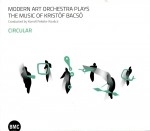 Jazz education, of which the abovementioned Graham Collier was a pioneer and later a critic, can produce technically proficient composers. But no matter how sincere their work may be, it may lack sharp edges. Reedman Kristóf Bascó, an exceptional product of advanced schooling in Hungary, France and the U.S., proves this point. On Circular (BMC CD 204 bmcrecords.hu), his seven compositions played by the 19-piece Budapest-based Modern Art Orchestra (MAO), deal with such important themes as fatherhood and death, and are performed faultlessly, but until the end lack a certain humanity. Voicings are impressive; the section blending is high quality; and the solos whether from Bascó’s limpid soprano or the muted trumpet of MAO conductor Kornél Fekete-Kovács are properly framed, yet hair-raising excitement is at a premium. To its credit the ensemble works towards that. Tenor saxophonist Jànos Ávéd honks ruggedly as the band riffs sympathetically behind him on Lunar Dance, while guitarist Màrton Fenyvesi cuts through the horns with unexpected rasps on Child’s Space. Only on the final – and most recent – cut does the narrative suggest why the MAO considered an all-Bascó program. Variations on a Folksong sways with a lively, likely folkloric beat and offers some meaty, stratospheric upturns from the ten-piece brass section.
Jazz education, of which the abovementioned Graham Collier was a pioneer and later a critic, can produce technically proficient composers. But no matter how sincere their work may be, it may lack sharp edges. Reedman Kristóf Bascó, an exceptional product of advanced schooling in Hungary, France and the U.S., proves this point. On Circular (BMC CD 204 bmcrecords.hu), his seven compositions played by the 19-piece Budapest-based Modern Art Orchestra (MAO), deal with such important themes as fatherhood and death, and are performed faultlessly, but until the end lack a certain humanity. Voicings are impressive; the section blending is high quality; and the solos whether from Bascó’s limpid soprano or the muted trumpet of MAO conductor Kornél Fekete-Kovács are properly framed, yet hair-raising excitement is at a premium. To its credit the ensemble works towards that. Tenor saxophonist Jànos Ávéd honks ruggedly as the band riffs sympathetically behind him on Lunar Dance, while guitarist Màrton Fenyvesi cuts through the horns with unexpected rasps on Child’s Space. Only on the final – and most recent – cut does the narrative suggest why the MAO considered an all-Bascó program. Variations on a Folksong sways with a lively, likely folkloric beat and offers some meaty, stratospheric upturns from the ten-piece brass section.
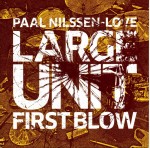 In sharp contrast Norwegian drummer Paal Nilssen-Love, whose musical education has been supplemented by playing experience with some of jazz’s most idiosyncratic soloists and bands, isn’t afraid of grittiness and slip-ups as his 11-piece Large Unit roars through First Blow (PNL Records PNL 021 paalnilssen-love.com), a CD-EP which preserves its initial live concert. Driven by the near Second Line-rhythm of twin drummers Andreas Wildhagen and Nilssen-Love, Culius opens up into polyphonic abandon reflected in flutter-tongued brass burp, atonal cries from the reeds and crackling burbles from Lasse Marhaug’s electronics. With the tune unfolding at tempos that range from horse-racing swiftness to country-road cantering and effortlessly switching from crescendos and decrescendos, the tune impresses with sheer force. The subsequent Motfølge proves that suggestion is as legitimate as shouting. Centred around Marhaug’s wispy processing and mechanized crunches, offside interjections and challenges from the other instruments appear and vanish. The asides range from gong-like clatter from the drummers to old-timey tailgate slurs from trombonist Mats Äleklint. Overall the program is the logical extension of Barry Guy’s BGNO concept.
In sharp contrast Norwegian drummer Paal Nilssen-Love, whose musical education has been supplemented by playing experience with some of jazz’s most idiosyncratic soloists and bands, isn’t afraid of grittiness and slip-ups as his 11-piece Large Unit roars through First Blow (PNL Records PNL 021 paalnilssen-love.com), a CD-EP which preserves its initial live concert. Driven by the near Second Line-rhythm of twin drummers Andreas Wildhagen and Nilssen-Love, Culius opens up into polyphonic abandon reflected in flutter-tongued brass burp, atonal cries from the reeds and crackling burbles from Lasse Marhaug’s electronics. With the tune unfolding at tempos that range from horse-racing swiftness to country-road cantering and effortlessly switching from crescendos and decrescendos, the tune impresses with sheer force. The subsequent Motfølge proves that suggestion is as legitimate as shouting. Centred around Marhaug’s wispy processing and mechanized crunches, offside interjections and challenges from the other instruments appear and vanish. The asides range from gong-like clatter from the drummers to old-timey tailgate slurs from trombonist Mats Äleklint. Overall the program is the logical extension of Barry Guy’s BGNO concept.



